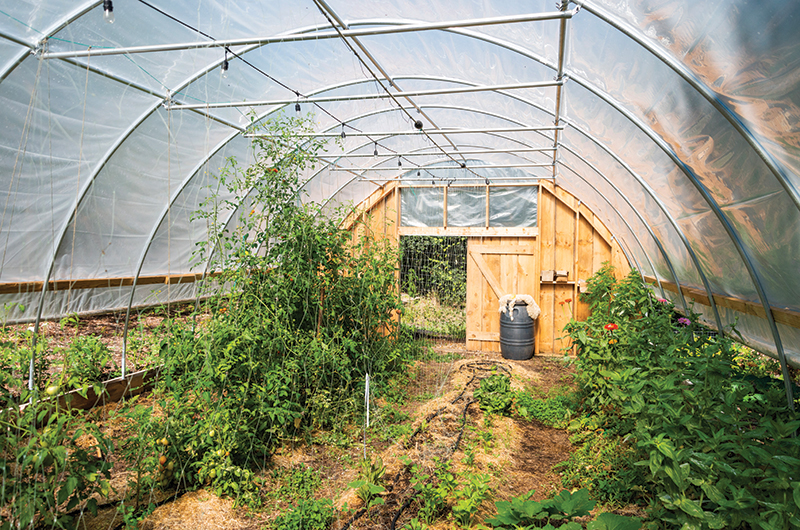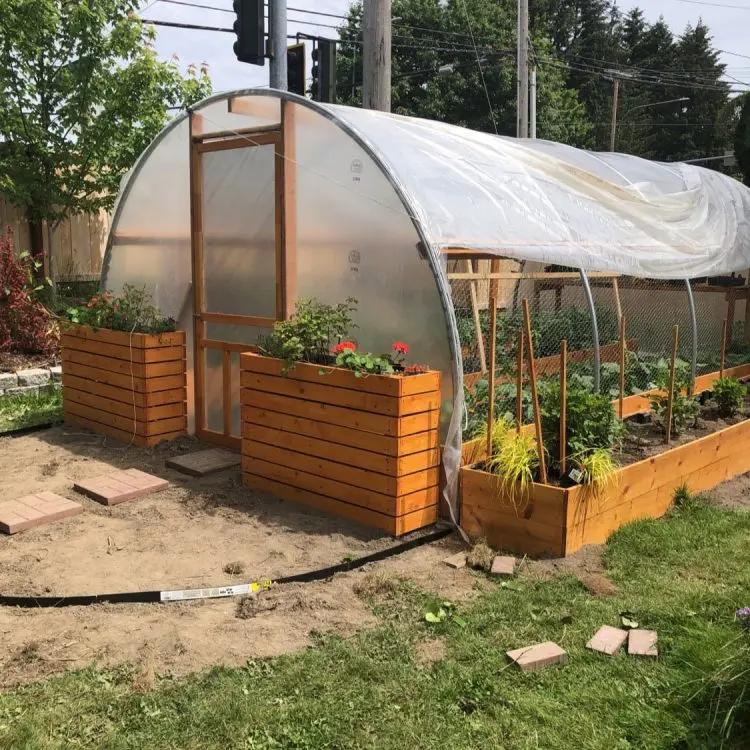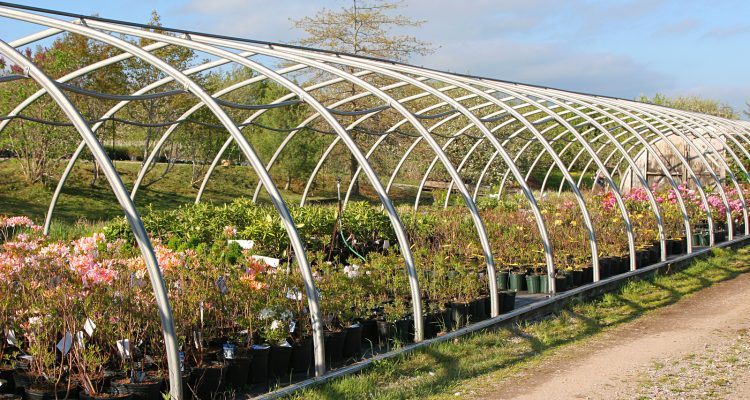As I stand in the midst of my lush, thriving garden, I’m reminded of the incredible journey I embarked upon when I first delved into the world of sustainable agriculture. It was a journey that led me to explore two remarkable structures that have revolutionized the way we grow crops: the hoop house and the greenhouse.
However, I’m a passionate gardener, and I’ve always dreamt of extending my growing season and cultivating a wide variety of crops year-round. Two distinct structures that offer unique advantages to growers like me. These structures are not just places to grow plants; they are symbols of our commitment to reducing our ecological footprint while enhancing food production.
A hoop house, or high tunnel, is a wallet-friendly option. It’s basically a curved frame with plastic over it. It helps plants grow longer, shields them from bad weather, and saves energy. On the flip, a greenhouse, carefully controls temperature, humidity, and light, providing a safe home for delicate and exotic plants to thrive all year round
So, whether you’re a seasoned gardener like me or just starting your journey into sustainable agriculture, join me as we navigate the fascinating world of hoop houses and greenhouses.
| Characteristic | Hoop House | Greenhouse |
| Structure | Typically has a simple, arched frame made of hoops or pipes covered with plastic or polyethylene. | Features a more permanent and solid frame structure made of materials like metal, wood, or aluminum, with glass or polycarbonate panels. |
| Construction Cost | Generally less expensive to construct due to the simpler frame and covering materials. | Tends to be more costly due to the use of durable materials and more complex construction. |
| Durability | Less durable compared to greenhouses; may require more frequent repairs and maintenance. | More durable and long-lasting, often with a longer lifespan than hoop houses. |
| Insulation | Offers less insulation and temperature control, making it suitable for season extension rather than year-round cultivation. | Provides better insulation and environmental control, allowing for year-round cultivation and precise climate management. |
| Ventilation | Limited ventilation options, typically relying on roll-up or drop-down sides for airflow. | Offers more advanced ventilation systems, including ridge vents, louvers, and automated systems for precise temperature control. |
| Heating and Cooling | Limited options for heating and cooling, often relying on passive methods like opening/closing vents and using shade cloth. | Equipped with heating, cooling, and climate control systems to maintain optimal conditions for plants year-round. |
| Purpose | Primarily used for season extension, protecting plants from frost, and extending the growing season. | Suitable for year-round cultivation, allowing for the growth of a wider variety of plants and crops. |
| Size and Commercial Use | Smaller in size and commonly used by small-scale or hobbyist growers. | Larger in size and commonly used in commercial agriculture for intensive crop production. |
What kind of plastic do you use for both?

Greenhouses typically employ more rigid glazing materials for their walls, such as glass or polycarbonate panels. While they can be covered with plastic film, the preference often leans toward thicker woven polyethylene if hard sides are not used.
In contrast, high tunnels or hoop houses strike a balance between affordability and durability by commonly utilizing 6 mil greenhouse plastic. This specific type of plastic undergoes UV treatment to withstand prolonged exposure to direct sunlight.
It’s imperative to verify that the plastic you’re purchasing is explicitly designed for outdoor use under direct sunlight and possesses this crucial UV-resistant property.
It’s worth noting that ordinary plastic sheeting, akin to what painters use to safeguard carpets, is ill-suited for extended outdoor applications in high tunnels or greenhouse settings due to its lack of UV resistance.
In additrttiton, properly sourcing and installing greenhouse plastic is vital to ensure the longevity of the covering material and the effectiveness of the structure in maintaining an optimal environment for plant growth
What Are Hoop Houses Best For?
Hoop houses, also known as high tunnel greenhouses, serve as semi-permanent structures primarily designed to extend the growing season for specific crops. These constructions involve the placement of a series of hoops securely anchored into the ground, constituting a labor-intensive endeavor.
| Advantages of Hoop Houses | Disadvantages of Hoop Houses |
| Compact size and frost protection | High cost |
| Extended growing season | Limited temperature control |
| Versatile use for various crops | Ventilation challenges, The short lifespan of plastic covering |
Constructing a Hoop House: A Streamlined Approach
Building a hoop house is a comparatively straightforward endeavor, demanding less effort and planning in contrast to a full-scale greenhouse. This versatile structure can be swiftly assembled with minimal materials. Below, I will show you a concise guide outlining the steps to create a small hoop house independently:
1. Site Selection: Begin by meticulously selecting an optimal site for your hoop house. Ensure it is free from the shadow of overhanging trees and is leveled, providing a stable foundation for your project.
2. Marking Parameters and Hoop Placement: Mark the boundaries of your desired hoop house location and establish the recommended distances for hoop placement. This groundwork is essential for maintaining structural integrity.
3. Hoop Formation: Bend and shape the hoops into arches, a defining characteristic of the hoop house design. These arches serve as the framework for the structure.
4. Covering with Greenhouse Plastic: Stretch high-quality greenhouse plastic sheets over the arches, securing them firmly at the edges. This step is pivotal in creating a controlled environment for your plants.
Hoop House vs. Greenhouse: Best Crops
| Crops for Hoop Houses | Crops for Greenhouses |
| Radish | Microgreens |
| Turnip | Salads |
| Squash | Broccoli |
| Beets | Herbs |
| Melon | Carrots |
| Eggplant | Spinach |
| Scallions | Asparagus |
| Kale | Cucumbers |
| Bok Choy | Okra |
| Spinach | Cabbage |
What are Things To Remember Before Building a Hoop House or a Greenhouse?

Here’s a condensed version of my personal experience and advice regarding these essential pre-construction considerations:
Groundwork and Preparation:
As I prepared to build my growing structure, whether it be a hoop house or a greenhouse, I knew that the foundation mattered greatly. First, I meticulously leveled the chosen site and removed any pesky weeds or unwanted plants that had taken root there. Ensuring proper drainage was also a key part of the groundwork to prevent waterlogged soil.
Planning for Greenhouses:
For the more intricate greenhouse, I quickly realized that extensive planning was in order. This involved selecting a suitable flooring material, typically soil, and the construction of walls necessitated a sturdy frame. Sourcing all the necessary materials and ensuring their availability before beginning construction was paramount.
Budget Considerations:
Budgeting was another crucial step. I took note of the one-time expenses for materials and construction, but I didn’t stop there. I also calculated ongoing costs such as energy consumption for the greenhouse, labor expenses, and other maintenance costs. Exploring grants offered by local governments for greenhouse construction was a worthwhile endeavor, especially if I met their requirements.
Site Selection:
Selecting the right site was a pivotal decision. I considered factors like prevailing wind directions, existing structures, the presence of shading elements, nearby trees, and the ease of access. These factors could significantly impact the success of my growing environment.
Best crop option :
As I embarked on my gardening journey, I found myself faced with the exciting prospect of choosing the perfect crops for my enclosed growing spaces. Here’s a glimpse into my selection of crops for both my hoop house and greenhouse, each carefully chosen to thrive in their respective environments:
For hook house
- Radish
- Turnip
- Squash
- Beets
- Melon
For greenhouse
- Microgreens
- Salads
- Broccoli
- Herbs
- Carrots
- Spinach
How to build up a greenhouse?
When it comes to greenhouses, I’ve discovered they serve a specific purpose exceptionally well. Greenhouses are primarily best suited for commercial retail endeavors, where the cultivation of plants outside of their typical growing season is essential.
Now, if you’re considering building your own greenhouse, here’s a glimpse into the process:
Size, Style, and Frame: Begin by selecting the size, style, and type of frame for your greenhouse.
Doors and Ventilation: Choose suitable greenhouse doors and a ventilation system to ensure proper air circulation.
Coverage: Decide on the type of covering material best suited for your greenhouse.
Heating and Cooling: Determine the appropriate heating and cooling systems necessary to maintain a stable climate.
Environmental Control: Develop a strategy for environmental control within the greenhouse.
Benches: Install benches to accommodate potted plants efficiently.
Materials: Order all the necessary materials in advance.
FAQs
Is a hoop house as good as a greenhouse?
Hoop houses have their advantages, such as affordability and season extension, but they may not offer the same level of year-round control as greenhouses.
What is a hoop house in a greenhouse?
A hoop house is not typically found “in” a greenhouse. Instead, it’s a standalone structure similar to a greenhouse but with a simpler, arched frame covered in plastic for season extension.
What is the purpose of a hoop house?
The primary purpose of a hoop house is to extend the growing season, protect plants from frost, and create a controlled environment for improved plant growth.
What is the difference between a hoop house and a tunnel?
Hoop houses and tunnels are often used interchangeably, but tunnels are generally smaller and more basic, while hoop houses are larger and offer more robust season-extension capabilities.
Why is it called a hoop house?
It’s called a hoop house because of its distinctive arched frame structure, often made of hoops or pipes, that gives it its characteristic shape.
Conclusion
To sum up, in the quest to optimize our gardening endeavors, the choice between a hoop house and a greenhouse can significantly impact our success. Both structures offer unique advantages and cater to different needs.
Then, once I found myself torn between the practicality of a hoop house and the sophistication of a greenhouse. The hoop house, with its affordability and suitability for extending the growing season, was a tempting option.
Furthermore, its simplicity and cost-efficiency appealed to the pragmatist in me. On the other hand, the greenhouse, with its precise climate control and year-round cultivation possibilities, beckoned with promises of lush greenery even in the dead of winter.
Ultimately, my decision hinged on my gardening goals and available resources. If you’re aiming to extend your growing season, protect plants from frost, or cultivate crops with modest budget constraints, a hoop house might be your go-to choice.
However, if you’re dreaming of year-round gardening, growing exotic species, or craving a controlled microclimate for your prized plants, a greenhouse might be the answer.

